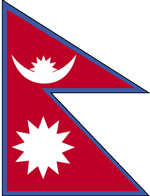Low Economic Interdependence in a Difficult Regional Environment
While the Indian economy has developed positively since 2014, its success has failed to spill over to the whole South Asian region. South Asia is the world region with the greatest untapped potential in terms of intra-regional trade and regional cooperation.
South Asia displays the greatest economic potential and, at the same time, the most formidable challenges for investment and trade among the world regions. Most countries in this region are, to different degrees, still struggling with poverty and domestic instability as well as with the challenges posed by poor infrastructure and corruption. At the same time, they are potentially interesting destinations for FDI and, being home to one fifth of the world’s population, they also constitute a huge market for exports. Among the many sources of South Asia’s untapped potential is its low degree of regional cooperation. In political and economic terms, in fact, South Asia is the least integrated region of the world.
The South Asian Association for Regional Cooperation
The main regional organization in South Asia, the South Asian Association for Regional Cooperation (SAARC), comprises India, Pakistan, Sri Lanka, Nepal, Bangladesh, Bhutan, the Maldives and, since 2007, Afghanistan. It was founded in 1985 with the aim of enhancing cooperation among regional states, but it never moved beyond extremely shallow forms of institutionalization. The driving forces behind the formation of SAARC were the smaller countries in the region: the government of Bangla-
desh took the initiative, the organization’s headquarters were established in Kathmandu, Nepal, and some of the region’s small states called for a deepening of regional integration.
However, the tense security situation in the region, and especially the longstanding conflict between India and Pakistan over Kashmir ultimately led to the inclusion in the SAARC Charter of a formulation that bans ‘political and contentious issues’ from the organization’s agenda. This formulation, which de facto emasculates SAARC as a political organization, was strongly favored by India. New Delhi was opposed to any kind of collective security cooperation in the region. Moreover, India rather explicitly slowed down the process of regional integration and pushed for the inclusion in the SAARC charter of the unanimity principle for decision making.
While these preferences reflected the value that India generally attached the principle of sovereignty in foreign policy making, they were also clearly related to New Delhi’s fear of being limited in its room to maneuver by its smaller regional neighbors. The resulting tension and mistrust among South Asian countries has continued to date and still hampers regional cooperation. Besides the rivalry between nuclear-armed India and Pakistan, most of the smaller SAARC countries are suspicious of India. This is due to historical memories about Indian meddling in their internal affairs in the 1980s, but also to the very geopolitical setting of South Asia.
India accounts for over 70 percent of the region’s geographical area and population, and is centrally located in a hub-and-spokes setting, in which none of the smaller regional countries borders another, with the exception of Afghanistan-Pakistan. Paradoxically, the high degree of cultural similarity among South Asian countries might have reinforced mistrust, instead of mitigating it. In fact, small countries like Sri Lanka or Bangladesh, whose population (or sections of it) shares a common language with the population of bordering Indian union states, have long feared being absorbed by their overwhelmingly dominant neighbor.
While fears about potential Indian expansionism have subsided as India has clearly behaved as a ‘satisfied’ power in dealing with small regional countries, there is still some degree of mistrust about Indian meddling. As a consequence, small South Asian countries have welcomed Chinese investments and have started playing India and China out against each other. A range of Chinese port projects in Pakistan, Sri Lanka and Bangladesh has, in turn, been perceived by India as a ‘string of pearls’ potentially able to ‘strangulate’ India by encircling it along the Indian Ocean.
Limited Regional Integration
Overall, therefore, the South Asian region is marred by political tensions that have emerged out of the asymmetric geopolitical setting, unresolved territorial disputes, and suspicions resulting from past policies. Given the lack of a strong political will to promote regional integration, SAARC has never taken off – neither in political nor in economic terms. The consequences are tangible. Trade among South Asian countries is extremely limited.
While an agreement for the creation of a South Asian Free Trade Area (SAFTA) was signed in 2006 and India has unilaterally given dutyfree access to its market to the Least Developed Countries (LDCs) of South Asia (Afghanistan, Bangladesh, Bhutan, the Maldives, and Nepal), only 5 percent of South Asian countries’ total trade is intra-regional. By way of comparison, among ASEAN countries, 25 percent of total trade takes place within the region. While complementarities among South Asian economies are limited, experts agree that there is still huge room for improvement and the possibility of creating complementarities through appropriate policy reforms.
Among the causes of the limited amount of intra-regional trade are long sensitive lists that all countries have decided to retain. More over, different types of non-tariff barriers are still in place, especially technical barriers to trade, sanitary regulations, quotas, anti-dumping measures and license requirements. Just to mention a few examples, India and Sri Lanka have a Free Trade Agreement, but tea and garment exports from Sri Lanka to India cannot be cleared at all ports; in Bangladesh, 38 per-
cent of protection is reportedly due to ‘para-tariffs’ like surcharges and supplementary duties which do not fall under the SAFTA definition of tariffs; and in Sri Lanka, the import of spices and tea is prohibited.
In order to facilitate trade, it would be also necessary to reduce the volume of documentation required to obtain clearances, to introduce modern customs procedures supported by information technology, and to increase the transparency of export and import requirements. As far as services are concerned, the South Asian countries signed the SAARC Agreement on Trade in Services in 2010, after several years of negotiations.
However, also in this case implementation is lagging behind. Intraregional FDI is still extremely limited, even though South Asian countries have partially opened their markets to FDI since the 1990s. Of total cumulated FDI inflows into the South Asian region over the past three decades, only 5 percent were intra-regional. Among the main problems hampering regional economic cooperation is the limited connectivity among South Asian countries.
Paradoxically, in many cases South Asian borders are porous, allowing for undocumented migration, for cross-border activities of rebel and terrorist groups (for exam-
ple in the border areas of Pakistan and Afghanistan) and for all sorts of smuggling – while at the same time formal borders are highly impermeable. Visa regimes are tough, making people-to-people and commercial exchanges difficult among South Asian countries – despite the huge cultural similarities among them. For the move-
ment of goods, border crossings are frequently dysfunctional and not adequately equipped to handle the necessary volume of traffic, thereby leading to long delays in cross-border trade.
Storage facilities, for example at the India-Bangladesh border, are inadequate. More generally, cross-border infrastructure connecting South Asian countries is still extremely poor. For example, only few cross-border train connections exist among the countries of South Asia. After having been disrupted for over four decades, a train service linking Bangladesh’s capital Dhaka to the Indian city of Kolkata in West Bengal restarted only in 2008.
Recently, the Indian and Bangladeshi governments commissioned a feasibility study for a railway link between the Indian north eastern state of Tripura and the city of Chittagong in Bangladesh. The Indo-Ceylon express, which connected the southern Indian state of Tamil Nadu to Sri Lanka, has not been operational since 1964. After the end of the civil war in Sri Lanka in 2009, ferry connections between Sri Lanka and India restarted only in 2012 and were suspended after few months. Only recently, some plans to restart the ferry service have come up.
Road infrastructure is poor as well. As a consequence, a container would not be transported from Delhi to Dhaka via the land route through Kolkata – it would, instead, be shipped all around the Indian subcontinent, taking around 35 days to reach its destination. Paradoxically, most intraregional trade takes place along maritime routes – for example, India- Pakistan trade takes largely place via Dubai or Singapore.
In sum, SAARC has failed to take off due to political tensions, and this has had huge implications for the integration of the South Asian region as a whole. Despite very close cultural relations, we have a range of countries separated by nearly insurmountable bureaucratic and infrastructural barriers. This makes South Asia a somewhat ‘insular’ sub-region, especially if compared to the much more integrated ASEAN region.
Against the backdrop of the several ‘Silk Roads’ that have been developing over the past years – strongly driven, among others,by China – the South Asian region risks being further sidelined and isolated from major worldwide economic flows.
Bhutan
| BIP (%) | BIP pro Kopf (US-Dollar) |
|---|---|
| 2014: 6,4 | 2.730 |
| 2015: 7,6 | 2.884 |

Der überraschende Wahlsieg der vormaligen Oppositionspartei People’s Democratic Party (PDP) unter Tshering Togbay im Juli 2013 brachte den ersten Regierungswechsel nach dem Übergang Bhutans zu einer konstitutionellen Monarchie. Herausforderungen der amtierenden Regierung bleiben die Integration der Nepalisprechenden Minderheit im Süden des Landes, die Schaffung eines unabhängigen und effizienten Justizsystems, Freiheit der Medien und Toleranz gegenüber nicht-buddhistischen Bevölkerungsgruppen. Außenpolitisch bemüht man sich um gute Beziehungen insbesondere zu China und Indien.
In den vergangenen Jahren hat Bhutan das Konzept der Gross National Happiness (GNH) als Alternative zum Gross Domestic Product (GDP) als Maßstab zur Beurteilung wirtschaftlicher und sozialer Entwicklung erfolgreich vorangetrieben. Der aktuelle Fünf-Jahres-Plan (2013-2018) baut auf den vier Kernelementen der GNH auf (gerechte und nachhaltige sozio-ökonomische Entwicklung, gerechte und nachhaltige Werte, Bewahrung der natürlichen Umwelt, gute Regierungsführung). Das angestrebte Wirtschaftswachstum hängt vor allem an der termingerechten Fertigstellung von zehn Wasserkraftwerken, da der Energieexport die hauptsächliche Stütze der Außenwirtschaft darstellt. (Quelle: Wirtschaftshandbuch 2014/2015)
The Road Ahead
On a more positive note, however, the low degree of regional integration that we currently observe in South Asia bears huge potential for improvement. If the govern-
ments of regional countries were able to overcome their political animosities, the region could transform into a thriving economic environment. After all, with an annual average GDP growth rate of 6.9 percent during the decade 2000-10 and an estimated growth of 5.5 percent in 2014 (after a 10-year low of 4.9 percent in 2013 – World Bank data), South Asia is already one of the most dynamic regions in the world.
According to a World Bank report, South Asia was even the fastestgrowing region in the world in the last quarter of 2014. A greater economic integration will allow for potentially beneficial spillover effects from the Indian economy to those of smaller regional countries, making India not just an asymmetrically dominant neighbor, but an engine of growth for the whole region. In political terms, there could hardly be a better moment for substantial change.
Over the past two years, elections in several South Asian countries have brought to power new governments potentially more willing to cooperate. India’s new prime minister, Narendra Modi, has declaredly made the improvement of relations with South Asian countries one of his foreign policy priorities. When he came into office in May 2014, Modi made a gesture that would be insignificant in other regions, but was almost revolutionary in South Asia: he invited all heads of state and government of the South Asian countries to his inauguration as a Prime Minister.
Modi’s visit to Nepal in August 2014 was the first visit by an Indian prime minister to that country in 17 years – a rather long period of neglect for two countries that declaredly have a special relationship. In 2015, the new Indian Foreign Secretary travelled extensively to the neighboring countries, indicating a further increased willingness on the part of New Delhi to interact with them. Beyond these diplomatic initiatives, moreover, some concrete steps have been taken that are indicative of new efforts to improve connectivity. For example, India and Bangladesh are planning to expand their cross-border electricity transmission line, while India and Bhutan agreed in 2014 that they would deepen their trade and energy connectivity.
In the context of the SAARC, the SAARC Framework Agreement for Energy Cooperation (Electricity) was signed at the latest Summit meeting held in Kathmandu in November 2014. However, despite existing goodwill, problems remain in place. For example, disagreements between Pakistan and India during the 2014 SAARC Summit made it impossible to conclude two further badly needed agreements, on vehicular traffic facilitation and railway connectivity, respectively. Moreover, the domestic political situation in several South Asian countries remains volatile.
Bangladesh continues to be plagued by severe political unrest; Afghanistan is in the midst of a delicate phase of political transition and will need to get increasingly in-
dependent in the management of its own security; Nepal will have to struggle with the consequences of a devastating earthquake that hit it in April 2015; civil-military relations in Pakistan will continue to play a major role in shaping the tense relationship with India.
To conclude, while there is some hope for improvement in regional cooperation among South Asian countries, deep mistrust and long-held mutual suspicions will require a long time to dissipate. For deeper integration in the South Asian region, the road ahead will be long.
Nepal
| BIP (%) | BIP pro Kopf (US-Dollar) |
|---|---|
| 2014: 5,5 | 699 |
| 2015: 5,0 | 763 |

Nach den freien und fairen Wahlen am 19. November 2013 regieren seit Mitte März 2014 unter Premierminister Sushil Koirala der Nepali Kongress und die Kommunistische Partei Nepals das Land. Die Regierung konnte das Mandat, bis Januar 2015 die Verfassung zu verabschieden, aufgrund der Widerstände Seitens der Maoisten und deren Verbündeten nicht erfüllen. Außenpolitisch hat sich das bisher schwierige Verhältnis zu Indien durch den Staatsbesuch des indischen Premierministers Anfang August 2014 verbessert. China, Nepals zweitwichtigster bilateraler Partner, hat seine Entwicklungszusammenarbeit mit Nepal mit der Sicherheitspolitik in Tibet verknüpft. Die erfolgreichen Wahlen im November 2013 waren das lang erwartete positive Signal für die Wirtschaft. Seit Anfang 2014 kommt es wieder zu Geschäfts- und Investitionsanfragen ausländischer Geschäftsleute. Der Mangel an politischen Programmen verursacht jedoch einen immensen Reformstau. Das Ziel der Regierung ist es, Nepal bis 2022 von einem „am wenigsten entwickelten Land“ in ein Entwicklungsland zu verwandeln. Infolge der Erdbebenkatastrophe im April 2015, die über 8.000 Menschen das Leben kostete, befindet sich das Land im Ausnahmezustand. (Quelle: Wirtschaftshandbuch 2014/2015)
